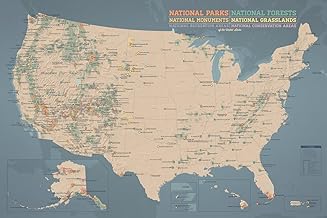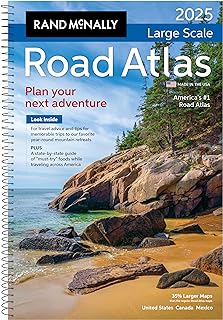5 important factors worth considering when looking for the best maps ever national park map
When you set out on an adventure to explore national parks, a good map can be your guide. Choosing the right map is important for making sure your trip is enjoyable and successful. Things like how well the trails are marked and what information is included about facilities and attractions can make a big difference in your experience. Having a good map can turn your outdoor adventure into a memorable exploration of the natural world.
See our guide to the best maps ever national park map.
Scale and detail
Selecting the right map for a national park is important, as it can greatly impact your outdoor experience. A map with the right scale gives you a wide view of the park’s terrain while still showing enough detail for navigation. This makes it easier to plan your adventures and choose the best routes. However, too much detail can overwhelm the map, while too little can leave out important information.
Choosing a map that balances scale and detail is key for a successful and enjoyable trip in any national park. A well-made map can not only help you navigate but also help you understand the natural and cultural aspects of the park. It can show you the topography, trails, points of interest, and ecological features, enriching your journey with a deeper appreciation for the surroundings.
Investing in a map that accurately captures the park’s essence allows you to fully immerse yourself in its beauty and diversity. A good map can guide you through nature’s wonders and help you connect with the environment on a profound level.
Accuracy and reliability
When heading outside, a good map can be your best friend. Maps of national parks are especially important for helping people find their way through unfamiliar areas. These maps need to be accurate to prevent any dangers or problems that could arise from wrong information. Having a good, updated map of a national park can make sure your outdoor adventure is safe and enjoyable.
Even though digital maps are getting better all the time, there is something special about using a physical map to plan your journey and feel more connected to the land. The reliability of a national park map depends on the hard work and knowledge of the people who create it. They need to carefully check every detail to give adventurers a map they can trust to help them explore the natural world.
Topographical features
When you look closely at national park maps, you can find hidden treasures of adventure. The lines and shapes on the maps show the different landscapes and beauty of these protected areas. They can guide both experienced hikers and beginners on their journey.
Studying a national park map can help you become a better navigator and feel more connected to the land. The elevation lines, rivers, and rocks on the map show how strong and amazing nature is. Understanding these details can lead to more exploration and a greater appreciation for the beauty of nature.
By paying attention to the details on the maps, we can feel inspired and connected to the outdoors. These maps show the special relationship between people and nature, and the endless wonder of the world around us.
Trails and points of interest
Exploring national parks can be greatly enhanced by investing in detailed maps. These maps not only guide you but also help you discover hidden gems and unexplored areas within the parks. By following the trails and points of interest on these maps, you can make exciting discoveries that go beyond typical travel experiences. The thrill of finding secluded waterfalls, stunning viewpoints, and rare wildlife encounters is all thanks to a well-made map revealing the secrets of a park’s true character.
Purchasing a national park map shows your commitment to fully embracing the adventure ahead. It symbolizes your willingness to step into the unknown with curiosity and respect. Having the right tools to navigate the park not only improves your safety and efficiency but also deepens your connection to nature. As you plan your route, follow the paths, and understand the symbols on the map, you truly embody the spirit of exploration. Therefore, when embarking on a national park adventure, let the map be your trusted guide, sharing stories of wonder and inviting you to experience the wild beauty of the outdoors.
Navigation aids
When it comes to buying a map for national parks, having reliable navigation tools is really important. Some people may say that smartphones and GPS devices have made traditional maps unnecessary. But there’s something special about using a paper map and following your path with your finger. Paper maps give you a physical connection to your surroundings and help you figure out where you are in a way that technology sometimes can’t match. Symbols like contour lines and trail markers on a good map guide you through the wilderness and let you fully enjoy exploring nature.
In a world full of digital options, the appeal of a physical map is its simplicity and dependability. Being able to find your location without worrying about a dead battery or lost signal is a luxury that experienced explorers rely on. And investing in a quality map with clear information can enhance your outdoor experience by giving you a better understanding of the terrain and landmarks. While technology has its place in navigation, there’s something special about a traditional map when you’re exploring the complex paths of national parks.
Conclusion
In summary, national park maps are both beautiful and useful, showing us how to explore and protect these natural wonders. They help us connect with the beauty of the world around us, guiding us through trails and landscapes that remind us to preserve these treasures for the future. The detailed and accurate maps of national parks show our shared love for the outdoors and our commitment to protecting the diverse ecosystems that make our planet special. Want more info on friend, check the best friend.


